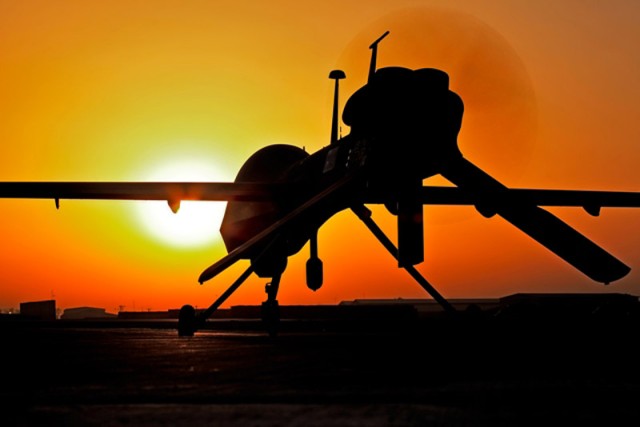ARLINGTON, Va. (Army News Service, Jan. 14, 2011) -- Despite budget constraints, the Army's Unmanned Aircraft Systems are growing, especially the Gray Eagle program.
"And with the budget movements afoot for the 2012 fiscal year, we will accelerate the Gray Eagle from two companies per year to three companies per year," said Tim Owings, deputy project manager for Unmanned Aircraft Systems.
Owings was among Army leaders speaking at the Association of the U.S. Army Aviation Symposium and Exposition which brought more than 500 military, government and industry professionals to discuss how to best sustain and acquire the required materiel to directly support the aviation warfighter and combatant commander during combat operations.
Although the theme for the Jan. 12 to 14 event at the Gaylord National Hotel and Convention Center was "Full Spectrum Aviation: Resilient and Adaptive for the Future Security Environment," the Unmanned Aircraft System garnered much interest with its ability to save lives on missions that are often referred to as too dull, dirty or dangerous for manned aircraft.
"We also expect to be funded to fill our needs for both video and wide-area surveillance capability," Owings said of the UAS program, adding that the Army will be asking for procurement of five additional attrition aircraft in February.
The Gray Eagle, one of the largest programs managed by UAS, will provide combatant commanders a much-improved real-time responsive capability to conduct long-swell, wide-area reconnaissance, surveillance, target acquisition, communications relay, and attack missions, Owings said.
The Gray Eagle addresses an ever-increasing demand for greater range, altitude, endurance and payload flexibility. At 3,200 pounds, this UAS has improved take-off and landing performance, coupled with the flexibility to operate with or without satellite communications data links. These are just some of the characteristics that make this system a combat multiplier.
"Gray Eagle is really the ultimate enabler for what we're trying to do," said Owings.
"With the Shadow class of systems at brigade and the smaller class at battalion and below, you need to have a way to cue those systems to the targets, which we do with a variety of intel feeds," Owings said. "But the Gray Eagle will allow us to carry wide-area surveillance sensors, a wider array of payloads, and become a top-level cueing platform for us."
"It also becomes the network enabler in order for us to increase dissemination, not just from Gray Eagle, but from our other stuff because you can pass the information through Gray Eagle to the ground and things of that nature. So from that perspective, it is super important," Owings said.
"The other important breakthrough is MUSIC, which stands for manned-unmanned systems integration capability. This will showcase complete and seamless interoperability between manned assets, unmanned assets and Soldiers on the ground," Owings said.
"So, in effect, what you're going to have is a universal operator being able to fly - whether it's a mid-range Shadow system, a larger Gray Eagle system, a Hunter system -be able to switch back and forth between those, or hand off control of that UAS to an Apache operator who can use that vehicle to laze for him or something of that nature, but for the Apache operator to be able to see the image and control the aircraft from the cockpit of the Apache," Owings said.
According to Lt. Col. Jennifer Jensen, product manager for Common Systems Integrations, Unmanned Aircraft Systems, a demonstration of these capabilities will occur at Dugway Proving Ground later this year.
"The Army has always been seen as a leader in making our systems as interoperable as possible. So, we're going to leverage off the one system remote video terminal that we started fielding in 2007 and expand that capability to the manned aircraft, because we put that technology into the Apache and the OH-58 and also the command and control Black Hawk," Jensen said.
"But what we're going to do on Sept. 16 at Dugway in Utah is demonstrate these capabilities and go a little bit farther," she said.
According to Jensen, the Shadow, the Hunter and the Gray Eagle will be flown using the new universal ground control station that UAS has been fielding.
"Along with that, we're going to demonstrate the control from that one system remote video terminal - we call the OSRVT - from a couple of our platforms - their payloads. And that's the first time that we've ever done that for an audience in real life, not just in the simulation environment," Jensen said.
Also being highlighted, she said, are the Apaches, and the OH-58, doing some other operations, as well as, relays with the UAS unmanned systems and potentially even fire weapons.
"And, lastly, we're going to demonstrate our small aircraft family, the Raven and the Puma, being flown from a single controller. So we're very excited about this demonstration." Jensen said.
UAS will announce this demonstration in more detail this spring.
"This MUSIC demo is going to show all this integration, all this interoperability, and how everything is now coming to fruition. This has always been a plan for the Army and the direction we want to go to have all this seamless integration," said Col. Rob Sova, U.S. Army Training and Doctrine Command capabilities manager.
"Ground control becomes our center of gravity, and the systems in it will allow us to continue to operate whatever new technology comes not only from an air platform standpoint, but working with our maneuver center of excellence, from our infantry, as well. We have that capability and technology now," Sova said.
Related Links:
Army hits 1 million flight hours with unmanned aircraft
Army civilians work to provide lethal aerial vehicles to Soldiers
Army.mil: Science and Technology News
STAND-TO!: Army Unmanned Aerial Systems Hits One Million Flight Hour Milestone


Social Sharing